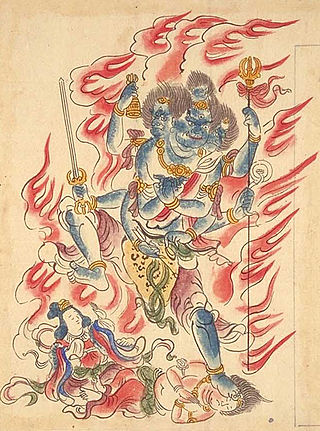Top Qs
Timeline
Chat
Perspective
Trailokyavijaya
Buddhist king of knowledge From Wikipedia, the free encyclopedia
Remove ads
Trailokyavijaya (Chinese: 降三世明王; pinyin: Xiángsānshì Míngwáng, Japanese: Gōzanze Myō-ō; Korean: Hangsamse Myeongwang; Sanskrit: त्रैलोक्यविजय) is a Buddhist wrathful deity and is considered to be a form of the bodhisattva, Vajrapani. He plays an important role in the seventh-century text, the Tattvasaṃgraha Tantra where Vajrapani takes the role of Trailokavijaya.
This article includes a list of general references, but it lacks sufficient corresponding inline citations. (December 2014) |


Remove ads
History
The worship of Trailokavijaya in China began following the transmission of various texts into the region including the Tattvasaṃgraha Tantra and the Vairocanābhisaṃbodhi Sūtra which were translated into Chinese by the monk, Amoghavajra at some point in the latter part of the eighth century. These texts were later transmitted to Japan.[1]
Iconographic representation
Lord Trailokyavijaya was born from the blue syllable, Hûm. He is blue, with four faces, and eight arms. His primary face expresses a love fury, the right, wrathful compassion, disgust in the left, and behind, that of heroism. His main hands bear the bell and vajra, his chest says Vajra-hum-Kara; his three right hands hold (in descending order) a sword, the elephant hook, and an arrow; the three left hands hold a bow, lace, and a chakram. He carries, among other adornments, a garland made of a cord of Buddhas, is being developed as identical to him, that has (according fingers) magic gesture after touching fists back to back, attach two small chain-like fingers. The formula is "Om", etc.[2][3]
Remove ads
Mantra
The magic mantra of the King of knowledge having conquered the three worlds is:
Namaḥ samanta vajrāṇām. Ha ha ha vismaye, sarva tathāgata viṣaya sambhava Trailokya vijaya hūm jaḥ svāhā!
See also
References
External links
Wikiwand - on
Seamless Wikipedia browsing. On steroids.
Remove ads
